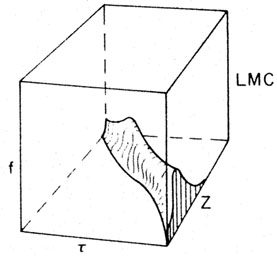Copyright © 1989 by Annual Reviews. All rights reserved
| Annu. Rev. Astron. Astrophys. 1989. 27:
139-59 Copyright © 1989 by Annual Reviews. All rights reserved |
5.3 The LMC
There is still a lack of agreement concerning some of the details about the history of the LMC, but there is no doubt about the gross features of the development of its population. It has large numbers of RR Lyrae variables (93, and many other references) and at least a few globular clusters of great age (118, and many other references), so it is clear that there was a significant period of star formation about 15 Gyr ago involving the formation of low heavy-element abundance stars. Subsequent star formation has surely gone on, but different studies find different patterns in the deduced rate of star formation. The views can be roughly separated into two extremes: Either the subsequent star formation rate has been approximately constant, with a gradually increasing heavy-element abundance (26, 66), or else there have been two (or perhaps more) episodes of vigorous star formation, dated at approximately 108 yr ago and 4 x 109 yr ago (45, 89, and many others). A review of the situation has been given by Lequeux (85) and is contained in the papers edited by van den Bergh & de Boer (128). Very recent discussions of this issue (37, 38, 43, 79, 105) continue to reach disparate conclusions about both the variation in the star formation rate and the abundance history for the LMC. Therefore, for this galaxy I show in Figure 11 a somewhat muted version of a nonuniform star formation history, in which, after a modest start, the LMC became particularly active a few billion years ago [possibly because of tidal effects, as discussed by Fujimoto & Murai (48)] and is again especially active now. It probably shows an unusually large dispersion in its present heavy-element abundances (88) because of its relatively relaxed dynamics and the consequent slow global mixing of its interstellar material.

|
Figure 11. The population history of the Large Magellanic Cloud (LMC). |